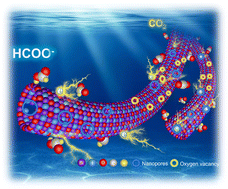Unlocking nanotubular bismuth oxyiodide toward carbon-neutral electrosynthesis†
Abstract
The electrochemical CO2 reduction reaction (CO2RR) to formate is one of the attractive strategies for achieving carbon-neutral sustainability, but synthesizing highly active catalytic materials capable of selectively forming formate, especially under industrially relevant conditions, remains challenging. We herein report ultrathin one-dimensional nanotubular Bi5O7I with substantial amounts of nanopores and oxygen vacancies for the CO2RR. A desirable selectivity of over 93% and high current density for formate are achieved in a potential window of 1000 mV in a flow cell. More importantly, a stable performance of 140 h with faradaic efficiency over 90% in a membrane electrode assembly system demonstrates great potential for industrial CO2RR application. The abundant defects within the ultrathin nanotubular structure not only improve the CO2 adsorption and charge transfer capabilities that facilitate the reaction kinetics, but also modulate the electronic structure and optimize the energy barrier toward formate as revealed by the theoretical calculations. Concurrently, the local high pH caused by the structural defects and hydrophobic surface could remarkably suppress the hydrogen evolution reaction and in turn, accelerate formate formation. These advances demonstrate an effective structure and defect engineering to unlock one-dimensional electrocatalysts to boost the CO2RR toward target products.

- This article is part of the themed collection: Carbon Dioxide utilisation


 Please wait while we load your content...
Please wait while we load your content...